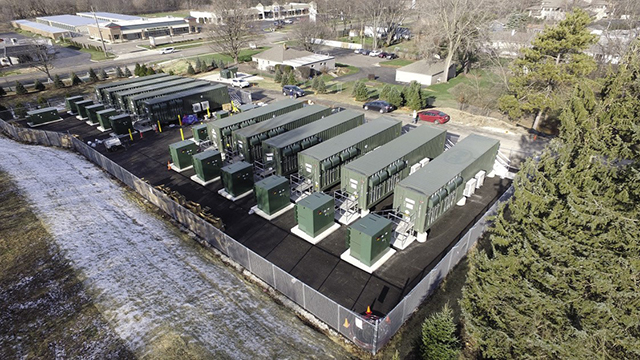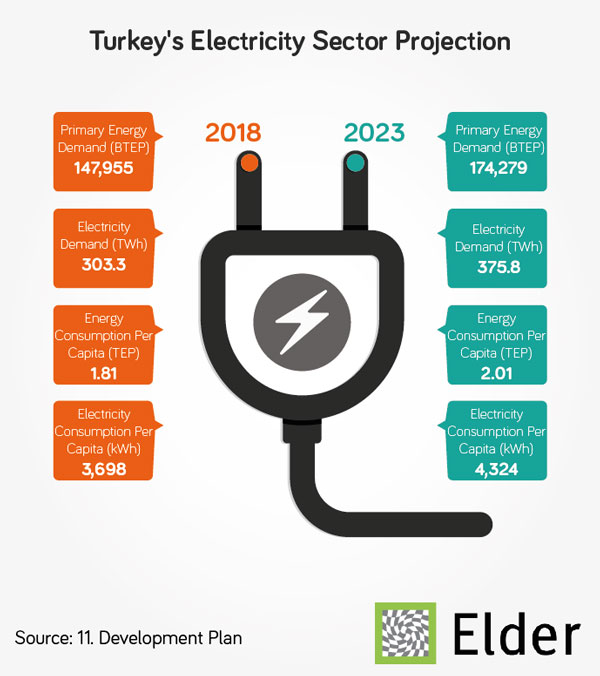
Turkey saved 900,000 tons of oil equivalent of energy thanks to $1.35 billion investment in energy efficiency.
Turkey's Energy and Natural Resources Ministry published a summary of development report on National Energy Efficiency Action Plan between 2017-2018.
According to the report, buildings got incentives for efficiency certificates of A and B class. Industry sector got 23.1 million Turkish Lira incentives and completed around 100 million Turkish lira investment.
Thanks to the investments, the industry saves 84 million annually.
Additionally, the overall investment in Turkey's energy efficiency projects stood at $1.35 billion between 2017-2018.
These investments provided the country with 900,000 tons of oil equivalent energy saving.

Turkey's Professional Competency Foundation (MYK) accredited the country's Electricity Distribution Company (TEDAS) as a commissioning institution in the power sector.
Speaking at an event between the two institutions, MYK head Adem Ceylan said that cooperation with other institutions is key to make work force quantitative.
In that sense, he reminded that, 4 jobs of TEDAS are included "dangerous" category and these jobs should receive professional competency certificates.
He added that they will work on the necessary studies to ensure that these jobs will be certificated.
TEDAS General Manager Halil Ibrahim Leventoglu said the cooperation between the two parties will continue.
With the accreditation of TEDAS by MYK, operation maintenance personnel of power distribution grid (Level 4), lineman of power distribution grid (Level 4), personnel working on leakage and measuring (Level 4), personnel working on fitting and removal of electricity meter (Level 3), index reading (Level 3) professions will be certificated.
Source: AA

Ridesharing and transportation platform Didi Chuxing announced today that it has formed a joint venture with BP, the British gas, oil and energy company, to build electric-vehicle charging infrastructure in China. The charging stations will be available to Didi and non-Didi drivers.
The news of Didi and BP’s joint venture comes one week after Didi announced that it had received funding totalling $600 million from Toyota Motor Corporation. As part of that deal, Didi and Toyota Motor set up a joint venture with GAC Toyota Motor to provide vehicle-related services to Didi drivers.
BP’s first charging site in Guangzhou has already been connected to XAS (Xiaoju Automobile Solutions), which Didi spun out in April 2018 to put all its vehicle-related services into one platform.
XAS is part of Didi Chuxing’s evolution from a ridesharing company to a mobility services platform, with its services available to other car, transportation and logistics companies. In June, Didi also opened its ridesharing platform to other companies, enabling its users to request rides from third-party providers in a bid to better compete with apps like Meituan Dianping and AutoNavi, which aggregate several ride-hailing services on their platforms.
Didi says it now offers ridesharing, vehicle rental and delivery services to 550 million users and covers 1,000 cities through partnerships with Grab, Lyft, Ola, 99 and Bolt (Taxify). The company also claims to be the world’s largest electric vehicle operator with more than 600,000 EVs on its platform.
It also has partnerships with automakers and other car-related companies, like Toyota, FAW, Dongfeng, GAC, Volkswagen and Renault-Nissan-Mitsubishi, to collaborate on a platform that uses new energy and AI-based and mobility technologies.
In a press statement, Tufan Erginbilgic, the CEO of BP’s Downstream business, said “As the world’s largest EV market, China offers extraordinary opportunities to develop innovative new businesses at scale and we see this as the perfect partnership for such a fast-evolving environment. The lessons we learn here will help us further expand BP’s advanced mobility business worldwide, helping drive the energy transition and develop solutions for a low carbon world.”
Source: Techcrunch

The annual revenue for energy distribution automation technologies is forecast to increase by 7.5% between 2019 and 2028.
Navigant Research predicts the annual revenue for the technologies will increase from $10.9 billion to $20.9 billion during the forecast period.
The growth in revenue is a result of utilities increasing their investments and focus in automating energy distribution systems over the next decade.
Utilities are aiming to increase grid reliability, visibility, resiliency, and flexibility by deploying automation solutions.
The energy distribution is the most critical, dynamic and fastest changing pieces of the 2019 electric grid, according to the research firm.
North America and Europe are witnessing high growth and significant distribution automation deployments, while the pure size and rate of development of the distribution grid in Asia Pacific bolsters the market and its growth rate there.
Developing regions such as Latin America, the Middle East and Africa include higher levels of automation for new construction, but existing are left unimproved.
Michael Hartnack, research analyst with Navigant Research, said: “The importance of distribution automation is consistent across all types of utilities.
“Ratepayer, regulator, and stakeholder demand for improved grid performance is driving much of this investment, with increasingly widespread deployments of distributed energy resources (DER) also growing the market.”
Source: Smart Energy International

Electricity production from solar panels in France rose 15.4% to a record 1.4-terawatt hour (TWh) in June due to long sunny spells and increased generation capacity, said the RTE power systems operator.
French solar power capacity rose 9.5% year-on-year in June compared with last year as more solar production units were connected to the grid, RTE said in its monthly report on Wednesday.
Electricity output from wind turbines across France soared 36% to 1.9 TWh compared with June 2018, boosted by the passage of Hurricane Miguel during the month, RTE said.
Wind power generation reached 11.4 GW on Friday June 9 at 1900 local time, covering 27% of French electricity consumption.
Over the weekend that followed, and coupled with lower consumption, total nuclear generation was lowered to 26.1 GW which was its lowest level in 15 years, RTE said.
Nuclear output, which accounts for around 75 percent of French power needs, slipped by 0.2% in June.
A lack of rainfall weighed on French hydropower supply which plunged 24% compared with the same month last year to 5.8 TWh.
RTE said French electricity consumption was stable at 32.6 TWh in June, although the highest peak consumption during a heatwave in 11 years was reached on June 27 at 58.7 GW.
It said that the French spot electricity price was the lowest in Europe during the month of June at 29.3 euros ($32.63) a megawatt hour (MWh) on average, down 8 euros compared with the previous month.
Source: Reuters

Within the Energy Union, the digital transformation of the energy sector requires to understand the interdependence between the Clean Energy Package and the Digital Single Market.
While the Digital Single Market provides new safeguards in the areas of personal data protection, free-flow of non-personal data and cybersecurity, the Market Design Initiative introduces new provisions closely related to the digitalization of the electricity sector. In particular, the provisions within the newly adopted Electricity Directive on demand response, dynamic prices, flexibility procurement, access to data, interoperability and data management.
Therefore, the European Commission DG ENER submitted this month a questionnaire on the challenges of digitalization of the energy sector with the intention to better understand the views of stakeholders.
The questionnaire focusing on energy data, digital platforms and solutions, cybersecurity and sector coupling will be answered by E.DSO by early September.
Source: EDSO For Smart Grids
People, Planet and Prosperity
Renewable energy is a key solution and the most practical action tool to address climate change. With rapid uptake of renewables, carbon dioxide (CO2) emissions would be about 70% lower than today, analysis by International Renewable Energy (IRENA) shows.
Please click here to read the full report.
24th World Energy Congress
September 09 - 12 / Abu Dhabi
Turkey Energy Forum
October 02 - 03 / Shangri La Bosphorus, İstanbul
Turkey Energy Summit
October 06 - 08 / Antalya
12. International Energy Congress- EIF
November 06 - 08 / Ankara
1. International Energy Summit 2019
November 21 - 24 / Antalya

